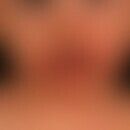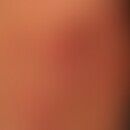Synonym(s)
DefinitionThis section has been translated automatically.
Refreshing wipes, also known as cosmetic wipes or wet wipes, which are usually made of cotton, viscose non-woven or crepe backing, and which are commercially available in various packaging formats, are enjoying increasing popularity. They are used for personal hygiene when travelling or in the gastronomic environment.
General informationThis section has been translated automatically.
Refreshing wipes contain a variety of ingredients. After a larger cross-sectional study (studies of 54 commercial refreshing wipes), an average of 11.9 ingredients per refreshing wipe were detected (KA Aschenbeck et al. 2017). It is important for the user of the wipes to know that the ingredients (according to the declaration obligation) are listed on the packaging in descending order of quantity.
Intolerance reactions or real allergic reactions are not uncommon with refreshing wipes, depending on the ingredients. The clinical symptoms are differently pronounced depending on the method and place of application, the extent and degree of intolerance.
Ingredient(s)This section has been translated automatically.
According to a cross-sectional analysis by KA Aschenbeck, the following ingredients are the most frequently used in refreshing towels in percentage terms:
- Aqua (100%)
- Aloe barbadensis extract (77.8%)
- Citric acid(citric acid) (77.8%)
- Fragrance (perfume - see below fragrances) (72.2%),
- Sorbic acid derivatives (seesorbic acid below) (63.0%)
- Tocopherol derivatives (63.0%)
- glycerine (59.3%)
- phenoxyethanol (55.6%)
- Disodium cocoamphodiacetate (53.7%)
- Disodium ethylenediaminetetraacetic acid (EDTA) (42.6%)
- Propylene glycol (42.6%)
- Iodopropynyl butylcarbamates (40.7%)
- Chamomile extracts (38.9%)
- Sodium benzoate (35.2%)
- Bronopol (22.2%)
- Sodium citrate (22.2%)
- Lanolin derivatives (20.4%)
- parabens (20.4%)
- Polyethylene glycol derivatives (18.5%)
- Disodium phosphates (16.7%)
- Dimethylol dimethyl (DMDM) hydantoin (14.8%)
- Cocamidopropyl propylene glycol (PG)-dimonium chloride phosphates (11.1%)
Other less frequently used ingredients:
- Methylchloroisothiazolinones
- Methylisothiazolinones
- PEG-40 Hydrogenated Castor Oil
- imidazolidinyl urea
- disodium EDTA
- citric acid
- Magnesium Nitrates
- Magnesium Chlorides
LiteratureThis section has been translated automatically.
- Admani S et al(2014) Methylisothiazolinone: a case of perianal dermatitis caused by wet wipes and review of an emerging pediatric allergen. Pediatric Dermatol 31:350-352.
- Aschenbeck KA et al (2017) Allergenic Ingredients in Personal Hygiene Wet Wipes. Dermatitis doi: 10.1097/DER.000000000 0000275.
- Cemek F et al.(2016) Personal Hygiene and Vulvovaginitis in Prepubertal Children. J Pediatr Adolesc Gynecol 29:223-227.
- Farage MA et al (2008) A randomized prospective trial of the cutaneous and sensory effects of feminine hygiene wet wipes. J Reprod Med 53:765-773.
- Liao C et al (2014) Concentrations and composition profiles of parabens in currency bills and paper products including sanitary wipes. Sci Total Environ 475:8-15.



